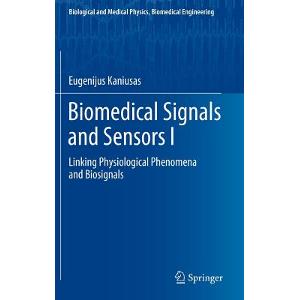Biomedical Signals and Sensors I: Linking Physiological Phenomena and Biosignals

Preface
The present two volume set focuses on the interface between physiologic
mechanisms and diagnostic human engineering. A multitude of biomedical sensors
are commonplace in clinical practice today. The registered biomedical signals,
which will be referred to as biosignals, reflect vital physiologic phenomena and are
relevant not only for the pre-screening and diagnosis of maladies but also for therapy
and follow-up treatment. For instance, the diagnosis of sleep apnea, i.e., abnormal
cessation of respiration during sleep, requires the monitoring of a complete set of
sleep and respiratory variables with at least eight different sensors distributed over
the entire body.
In order to adequately apply biomedical sensors and reasonably interpret the
corresponding biosignals, a proper understanding of the physiologic phenomena
involved, their influence on the registered biosignals, and the technology behind the
sensors is critical. Moreover, a nearly unlimited diversity of biosignals emphasizes
the need for a strategic approach in the genesis of biosignals, including a profound
understanding of fundamentally different mechanisms in a biosignal’s generation.
From a strategic point of view, biosignal generation involves the biosignal
formation path from the biosignal source at the physiological level, to biosignal
propagation in the body, to biosignal transmission in the sensor up to its conversion
to a, usually electric, signal. To give an example, heart sounds, an acoustic biosignal,
are created by the closure of heart valves, which constitutes the biosignal source.
Sound attenuation in the thoracic tissue represents the propagation mechanism.
Amplification and filtering of the heart sounds in the chestpiece (of the stethoscope)
reflect biosignal transmission effects in the sensor, with biosignal conversion being
performed by a microphone at the output of the chestpiece.
The first volume is focused on the interface between physiologic mechanisms
and the resultant biosignals, whereas the second volume is devoted to the interface
between biosignals and biomedical sensors. Unlike other contributions, this book
deals differently on the subject of either specific physiologic mechanisms or
specific engineering aspects pertaining to particular biomedical sensors, since it
emphasizes the interface between them. Both volumes systematically describe basic
mechanisms of biosignal formation while electric, acoustic, optic, and mechanic
biosignals are considered in depth.
In the given volume, the physiologic mechanisms determining biosignals are
described from the basic cellular level—as the place of origin of each and every
biosignal—up to their advanced mutual coordination level, e.g., during sleep.
It allows a physiologically accurate interpretation and comprehensive analysis of
the biosignals. The resultant biosignals are discussed within the scope of vital and
common physiologic phenomena to foster their understanding and comprehensive
analysis.
Download
http://s18.alxa.net/s18/srvs2/02/003....Sensors.I.rar

Preface
The present two volume set focuses on the interface between physiologic
mechanisms and diagnostic human engineering. A multitude of biomedical sensors
are commonplace in clinical practice today. The registered biomedical signals,
which will be referred to as biosignals, reflect vital physiologic phenomena and are
relevant not only for the pre-screening and diagnosis of maladies but also for therapy
and follow-up treatment. For instance, the diagnosis of sleep apnea, i.e., abnormal
cessation of respiration during sleep, requires the monitoring of a complete set of
sleep and respiratory variables with at least eight different sensors distributed over
the entire body.
In order to adequately apply biomedical sensors and reasonably interpret the
corresponding biosignals, a proper understanding of the physiologic phenomena
involved, their influence on the registered biosignals, and the technology behind the
sensors is critical. Moreover, a nearly unlimited diversity of biosignals emphasizes
the need for a strategic approach in the genesis of biosignals, including a profound
understanding of fundamentally different mechanisms in a biosignal’s generation.
From a strategic point of view, biosignal generation involves the biosignal
formation path from the biosignal source at the physiological level, to biosignal
propagation in the body, to biosignal transmission in the sensor up to its conversion
to a, usually electric, signal. To give an example, heart sounds, an acoustic biosignal,
are created by the closure of heart valves, which constitutes the biosignal source.
Sound attenuation in the thoracic tissue represents the propagation mechanism.
Amplification and filtering of the heart sounds in the chestpiece (of the stethoscope)
reflect biosignal transmission effects in the sensor, with biosignal conversion being
performed by a microphone at the output of the chestpiece.
The first volume is focused on the interface between physiologic mechanisms
and the resultant biosignals, whereas the second volume is devoted to the interface
between biosignals and biomedical sensors. Unlike other contributions, this book
deals differently on the subject of either specific physiologic mechanisms or
specific engineering aspects pertaining to particular biomedical sensors, since it
emphasizes the interface between them. Both volumes systematically describe basic
mechanisms of biosignal formation while electric, acoustic, optic, and mechanic
biosignals are considered in depth.
In the given volume, the physiologic mechanisms determining biosignals are
described from the basic cellular level—as the place of origin of each and every
biosignal—up to their advanced mutual coordination level, e.g., during sleep.
It allows a physiologically accurate interpretation and comprehensive analysis of
the biosignals. The resultant biosignals are discussed within the scope of vital and
common physiologic phenomena to foster their understanding and comprehensive
analysis.
Download
http://s18.alxa.net/s18/srvs2/02/003....Sensors.I.rar